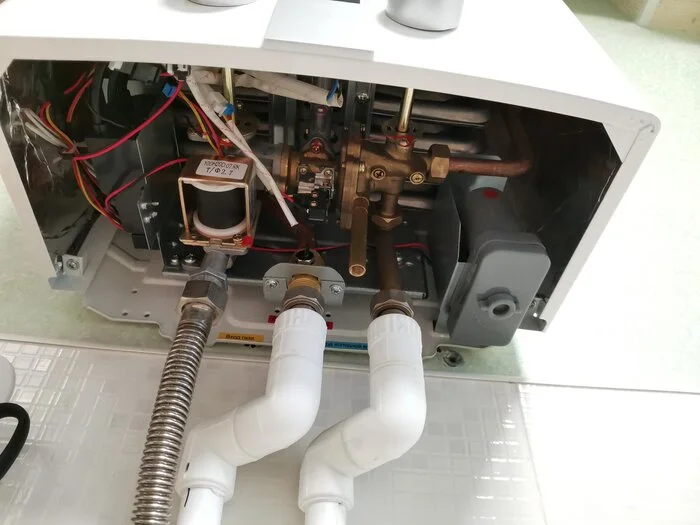Will a gas water heater work without electricity?
The short answer is no. Let’s elaborate more.
Gas water heaters have become a staple in modern homes for their efficiency and cost-effectiveness.
However, questions often arise about their functionality in the absence of electrical power. While it’s true that gas is the main fuel for heating water, the control systems that manage the temperature and safety features of the unit commonly depend on electricity.
Understanding the reliance of these appliances on electricity is crucial, especially for those who live in areas prone to power outages. It’s important to be aware of how such circumstances might affect the operation of your water heater, particularly if you are considering a tankless model.
Key Points
- Gas water heaters require electricity for their control panels to function.
- During a power outage, even tankless gas water heaters will not operate.
- Understanding this dependency is important for managing expectations during electrical outages.
Gas Water Heater Operations Without Electric Power

Gas water heaters are well know for their ability to heat water fast. However, it’s important to understand their dependence on electricity for certain functionalities.
Traditional tank-based gas water heaters can typically operate without electrical power, though their efficiency might be compromised. You will be able to use warm/hot water even if the electricity is off. However, after some time water will be cold again.
Conversely, on-demand or tankless gas water heaters utilize a control panel that requires electricity. This panel serves as the operational center of the unit.
The control panel on a tankless water heater serves several important functions that allow users to manage and monitor the operation of the appliance. Here are some of the typical purposes of a control panel on a tankless water heater:
- Temperature Control: It allows users to set and adjust the desired hot water temperature. This enables the water heater to provide hot water at a consistent and specific temperature for various uses such as showering, washing dishes, or laundry.
- System Diagnostics: Many tankless water heaters have self-diagnostic capabilities that can display error codes or system alerts on the control panel. This helps in identifying any issues with the heater, such as ignition failures, flame failures, or other operational problems.
- Status Indicators: The control panel often includes LED lights or a digital display that indicates the current operating status of the heater, such as whether it is actively heating water or in standby mode.
- Energy Monitoring: Some models may have features that allow users to monitor energy usage, which can help in managing energy consumption and potentially reducing utility bills.
- Preset Modes: Depending on the model, the control panel might have preset modes for different applications, such as a “vacation” mode that reduces energy consumption when hot water is not needed for extended periods.
- Maintenance Reminders: The control panel can also provide reminders for routine maintenance, such as flushing the system to remove mineral buildup or checking the condition of the filters.
- Child Lock or Safety Features: To prevent accidental changes to the settings or to enhance safety, the control panel might include a child lock or other safety features.
- Remote Control: Some tankless water heaters come with remote control panels that can be placed in a more convenient location, such as a bathroom or kitchen, for easier access to the controls.
Overall, the control panel is an essential part of a tankless water heater, providing the user interface for customizing and maintaining the performance of the unit, ensuring safety, and optimizing energy efficiency. [1]
| Feature | Detail |
|---|---|
| Fuel Source | Gas (Primary) |
| Electrical Need | Control Panel (Secondary) |
| Operation in Outage | Not operational without electrical power to the control panel |
These findings underscore the importance of having a backup power solution if continuous hot water access is critical during power outages. Despite the gas water heater’s independence from the grid for heating, the electrical components are necessary for its intelligent operation and overall safety protocols.
Using a battery backup for a tankless hot water heater and other gas appliances can ensure that they continue to operate during a power outage. Here’s a general guide on how to use a battery backup system:
- Choose the Right Battery Backup: Make sure the battery backup system you choose is rated for the voltage and current requirements of your tankless water heater and other gas appliances. It should also have enough capacity to power the appliances for the duration of the expected power outages.
- Installation: For safety and compliance with local codes, it is recommended to have a qualified electrician or a certified technician install the battery backup system. They will typically connect the system to the appliance’s power input and ensure that it’s properly grounded and safely installed.
- Automatic Transfer Switch: Many battery backup systems come with an automatic transfer switch (ATS) that detects when the power goes out and automatically switches the power source from the mains to the battery. The ATS should be installed by a professional.
- Manual Transfer Switch: If your system does not have an automatic transfer switch, you may need to manually switch the appliance from the mains to the battery backup when a power outage occurs. This typically involves plugging the appliance into the battery backup system.
- Regular Testing: Periodically test the battery backup system to ensure it is functioning correctly. This can often be done by simulating a power outage (e.g., by unplugging the appliance from the mains and allowing it to run off the battery backup).
- Maintenance: Maintain the battery backup system according to the manufacturer’s instructions. This may include checking the battery charge level, ensuring connections are tight and free of corrosion, and replacing batteries as needed.
- Adhere to Safety Precautions: Always follow the manufacturer’s safety instructions when using a battery backup system. Keep in mind that even though your tankless water heater may run on gas, the ignition system and controls require electricity, so the battery backup needs to supply the appropriate power for these components to function.
- Understand Limitations: Be aware that battery backups have a limited runtime based on their capacity and the power consumption of the connected appliances. They are generally intended for short-term power outages rather than long-term solutions.
- Consider Additional Features: Some battery backup systems may have additional features such as surge protection, which can help protect your appliances from voltage spikes when power is restored.
Related: How Long Do Water Heaters Last
Conclusion
While gas water heaters are generally designed to operate independently of electricity, some components need electrical power to operate. A solution for this issue can be a backup battery system designed especially for tankless water heaters.
Read Next: Switching From Gas To Electric Water Heater

Michael Davis is a heating & plumbing expert who currently works as independent contractor in SC. He also writes for Plumbertip.
For almost 10 years he worked on various plumbing tasks across South Carolina.


